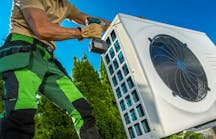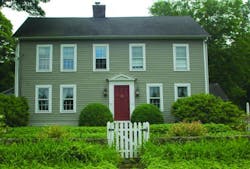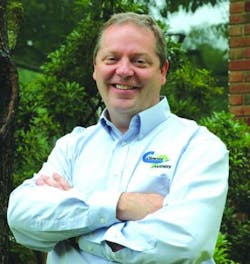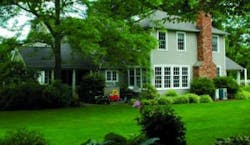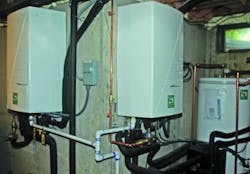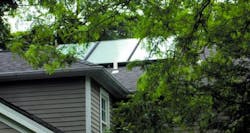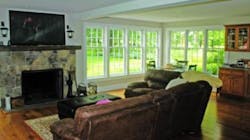2014 Quality Home Comfor Award Winner
Retrofit/Renovation up to 3,000 sq. ft.
"Welcome, Comfort"
Climate Partners, Milford, CT
At first glance, the project Sally and Tom Ajello approached Climate Partners about sounded fairly straightforward: replace the heating and cooling systems and improve indoor air quality at their home in Bethel, CT.
But the challenges quickly became apparent. The family of five would continue to live in the house during the project, the two halves of the house were ofdrastically different vintages and construction types, and it was winter, which meant peak heating season.
In addition, the homeowners were not interested in a traditional HVAC project. Their goal was to pursue renewable resources to heat and cool their home, plus heat their hot water, and in the process become 100% energy independent.
“The homeowners in this case are extraordinarily savvy,” said Tom Casey, Climate Partners’ chief quality officer. “They had done tons of research. They knew everything about every brand, and every contractor was researched. They knew what they wanted but they hadn’t heard yet how to get it.”
That’s where Casey and his team came in.
“What they liked about it was that we weren’t just talking about heating the house or cooling the house,” Casey said. “We were talking about the energy of the house, we were talking about renewable energy, we were talking about the future and being able to power things with solar. We were talking about the health of the occupants, the impact to the house and keeping the aesthetic a certain way.”
Tackling Problems with Solar, Hydronics
The house itself was the first challenge. The original farmhouse was built in 1796, and was insulated with corn cobs and newspapers. The addition — literally a second half — was added in 2000. The different halves of the home were performing very differently, making the home impossible to condition as desired.
Climate Partners’ solution was to prepare the house to convert entirely to solar, using photovoltaic cells and solar thermal collectors. The team removed the single two-zone heat-cool system and installed two inverter hydronic heat pumps, plus a dual heat exchanger indirect water heater. Each of the new systems was further broken down into two zones, allowing for precise control floor-by-floor for the old side and new side.
The first-floor duct system was reconfigured and expanded to accommodate the new second zone. The old duct chase to the attic was converted into a plumbing, drain and electrical chase for the new second-floor system. An entirely new second floor two-zone duct system was designed and installed.
A steam humidification system was applied on the second floor system with control in the master bedroom to ensure healthy sleeping conditions. Additionally, a spot filtration system was installed in the master suite to ensure particulate filtration. Both systems have UV air purification applied.
Solar panels were installed on the roof to create domestic hot water, in addition to the hydronic heat pumps. This design element qualified the project for an overall renewable energy tax credit for the homeowners, in addition to lowering their domestic hot water production costs.
To make sure all these systems were performing at peak efficiency and providing maximum comfort, Climate Partners designed an encapsulated attic system, consisting of spray foam insulation, that resulted in a dramatic reduction of infiltration and brought the mechanical systems into the thermal envelope. General building air sealing was also performed in the basement and crawl space areas, and a dehumidification system was installed.
One house with the bones of two made for a tricky process, from beginning to end. Careful planning and coordination were paramount during the nearly two-month-long project, according to Casey. Even the solar thermal panel installation had to be coordinated between snow accumulation.
“Working between the two parts of the house to ensure nothing was cracked or damaged, that everything sounded the same, and that everything looked the same between the two different styles of construction required a lot of care and real precise control and planning,” Casey said. “It was very methodical; each step had to be planned.”
The fact that all of this work was completed in the winter of the “polar vortex” while the family of five remained in the house was a minor miracle.
“There were 24 hours where we were going to be potentially without hot water and without heat, and it was one of those things we had to prepare for,” Ajello said. “It ended up not happening. We ended up maintaining all of our services throughout the project, which is incredible.”
And why was the project undertaken in winter? The Ajellos moved into the house in July, and started researching the project and contractors in August. By the time all the decisions were made and details were worked out, winter had arrived.
“We didn’t want to go a whole winter with the old system because we knew it was antiquated,” Ajello said. “We didn’t have a lot of confidence in the system so we wanted it out as soon as possible.”
Energy Efficiency
Casey said the system is the epitome of efficiency and green living.
Fossil fuels have been eliminated 100% in favor of renewable systems to provide all heating, cooling and domestic water heating. The system design and implementation was accomplished in accordance with BPI and Energy Star standards, with emphasis on reducing heat gain/loss, as well as particular attention to all ductwork, including duct sealing and duct insulation. The system also qualified for the Federal Tax Credit for Renewable Systems.
Casey said the system is super efficient as-is. But, to add perspective to how elegant the system is, each inverter heat pump is paired with a variable speed air handler and two-zone system, so over the wide range of outdoor and indoor conditions, the system can dial in precisely to maintain ideal comfort, always at the lowest operational cost possible.
This also applies to domestic water heating, which uses dual heat exchangers to prioritize solar thermal when available, actually eliminating heat pump operation when possible. The result? There are times when water heating costs $0.
Happy and Healthy
The Ajellos are satisfied with the outcome of the project and even have plans to work with Climate Partners on a few more projects in the future.
“We’re really happy with the system,” Sally Ajello said. “It’s definitely one of the more sophisticated and pricier systems to install but the benefits of that are we feel we’re living in a much healthier and safer house. The price is obviously worth it.”
Sally Ajello said she and her husband are ecstatic the project won a Quality Home Comfort Award.
“Tom and his team have done everything that they set out to do with the project,” she said. “They were really great to work with. I’d be happy to work with them again.”
Casey considers this project to be a highlight of his career.
“It was a hard job, and like a lot of things, sometimes persevering through challenges makes the end result more satisfying,” Casey said. “To push through such a challenging job with such a happy customer in the end, that’s amazingly satisfying.”
Long-term View
The Ajello house is the first retrofit project in Connecticut that combines heating, cooling and energy conservation in the way that it does, and it opens a new chapter for the industry, according to Casey.
“It seems like these worlds have all sort of existed separately,” he said. “This type of job that integrates it all taught us that it is possible to really on a deep level approach a house holistically.”
He said this project shows that it is possible to go into a regular neighborhood, in a regular house, and do things that many people think are only possible for new construction or homeowners with very deep pockets.
“The lesson here to me is we can go to existing houses and do amazing things to create energy independence, to create fully integrated solutions to the point where we can get existing houses to be net zero energy,” he said. “With this full approach of fixing the house, fixing the insulation, getting the mechanical systems right, using the right systems, integrating renewable energy like solar panels, we can actually have houses that create all the energy they use.”
This is important because in the future, more and more consumers are going to want to have control over their energy usage without sacrificing comfort or indoor health, according to Casey.
“There is a way, with the right planning and the right team, to do these things and make them work on a scalable level,” he said.
Elaine Yetzer Simon is a freelance writer based in Cleveland, OH.
